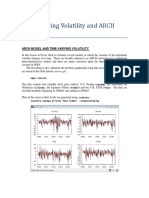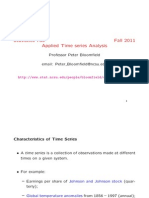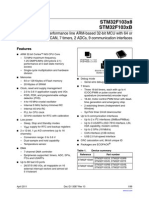Complete Guide To Create A Time Series Forecast (With Codes in Python) PDF
Uploaded by
Teodor von BurgComplete Guide To Create A Time Series Forecast (With Codes in Python) PDF
Uploaded by
Teodor von Burg21/6/2016
CompleteguidetocreateaTimeSeriesForecast(withCodesinPython)
Introduction
Time Series (referred as TS from now) is considered to be one of the less known skills in the
analytics space (Even I had little clue about it a couple of days back). But as you know our
inaugural Mini Hackathon is based on it, I set myself on a journey to learn the basic steps for
solvingaTimeSeriesproblemandhereIamsharingthesamewithyou.Thesewilldefinitelyhelp
yougetadecentmodelinourhackathontoday.
Before going through this article, I highly recommend reading A Complete Tutorial on Time Series
ModelinginR,whichislikeaprequeltothisarticle.Itfocusesonfundamentalconceptsandisbased
onRandIwillfocusonusingtheseconceptsinsolvingaproblemendtoendalongwithcodesin
Python.ManyresourcesexistforTSinRbutveryfewarethereforPythonsoIllbeusingPythonin
thisarticle.
Outjourneywouldgothroughthefollowingsteps:
1.WhatmakesTimeSeriesSpecial?
2.LoadingandHandlingTimeSeriesinPandas
3.HowtoCheckStationarityofaTimeSeries?
4.HowtomakeaTimeSeriesStationary?
5.ForecastingaTimeSeries
http://www.analyticsvidhya.com/blog/2016/02/timeseriesforecastingcodespython/
1/18
21/6/2016
CompleteguidetocreateaTimeSeriesForecast(withCodesinPython)
1.WhatmakesTimeSeriesSpecial?
Asthenamesuggests,TSisacollectionofdatapointscollectedatconstanttimeintervals.These
are analyzed to determine the long term trend so as to forecast the future or perform some other
formofanalysis.ButwhatmakesaTSdifferentfromsayaregularregressionproblem?Thereare2
things:
1.Itistimedependent.Sothebasicassumptionofalinearregressionmodelthattheobservationsare
independentdoesntholdinthiscase.
2.Along with an increasing or decreasing trend, most TS have some form of seasonality trends, i.e.
variationsspecifictoaparticulartimeframe.Forexample,ifyouseethesalesofawoolenjacketover
time,youwillinvariablyfindhighersalesinwinterseasons.
BecauseoftheinherentpropertiesofaTS,therearevariousstepsinvolvedinanalyzingit.These
arediscussedindetailbelow.LetsstartbyloadingaTSobjectinPython.Wellbeusingthepopular
AirPassengersdatasetwhichcanbedownloadedhere.
PleasenotethattheaimofthisarticleistofamiliarizeyouwiththevarioustechniquesusedforTSin
general.TheexampleconsideredhereisjustforillustrationandIwillfocusoncoverageabreadthof
topicsandnotmakingaveryaccurateforecast.
2.LoadingandHandlingTimeSeriesin
Pandas
PandashasdedicatedlibrariesforhandlingTSobjects,particularlythedatatime64[ns]classwhich
storestimeinformationandallowsustoperformsomeoperationsreallyfast.Letsstartbyfiringup
therequiredlibraries:
http://www.analyticsvidhya.com/blog/2016/02/timeseriesforecastingcodespython/
2/18
21/6/2016
CompleteguidetocreateaTimeSeriesForecast(withCodesinPython)
importpandasaspd
importnumpyasnp
importmatplotlib.pylabasplt
%matplotlibinline
frommatplotlib.pylabimportrcParams
rcParams['figure.figsize']=15,6
Now,wecanloadthedatasetandlookatsomeinitialrowsanddatatypesofthecolumns:
data=pd.read_csv('AirPassengers.csv')
printdata.head()
print'\nDataTypes:'
printdata.dtypes
Thedatacontainsaparticularmonthandnumberofpassengerstravellinginthatmonth.Butthisis
stillnotreadasaTSobjectasthedatatypesareobjectandint.Inordertoreadthedataasatime
series,wehavetopassspecialargumentstotheread_csvcommand:
dateparse=lambdadates:pd.datetime.strptime(dates,'%Y%m')
http://www.analyticsvidhya.com/blog/2016/02/timeseriesforecastingcodespython/
3/18
21/6/2016
CompleteguidetocreateaTimeSeriesForecast(withCodesinPython)
data=pd.read_csv('AirPassengers.csv',parse_dates='Month',index_col='Month',date_parser=datepa
rse)
printdata.head()
Letsunderstandtheargumentsonebyone:
1.parse_dates:Thisspecifiesthecolumnwhichcontainsthedatetimeinformation.Aswesayabove,the
columnnameisMonth.
2.index_col:AkeyideabehindusingPandasforTSdataisthattheindexhastobethevariabledepicting
datetimeinformation.SothisargumenttellspandastousetheMonthcolumnasindex.
3.date_parser:Thisspecifiesafunctionwhichconvertsaninputstringintodatetimevariable.Bedefault
PandasreadsdatainformatYYYYMMDDHH:MM:SS.Ifthedataisnotinthisformat,theformathas
to be manually defined. Something similar to the dataparse function defined here can be used for this
purpose.
Nowwecanseethatthedatahastimeobjectasindexand#Passengersasthecolumn.Wecan
crosscheckthedatatypeoftheindexwiththefollowingcommand:
data.index
http://www.analyticsvidhya.com/blog/2016/02/timeseriesforecastingcodespython/
4/18
21/6/2016
CompleteguidetocreateaTimeSeriesForecast(withCodesinPython)
Noticethedtype=datetime[ns]whichconfirmsthatitisadatetimeobject.Asapersonal
preference,IwouldconvertthecolumnintoaSeriesobjecttopreventreferringtocolumnsnames
everytimeIusetheTS.Pleasefeelfreetouseasadataframeisthatworksbetterforyou.
ts=data[#Passengers]ts.head(10)
Before going further, Ill discuss some indexing techniques for TS data. Lets start by selecting a
particularvalueintheSeriesobject.Thiscanbedoneinfollowing2ways:
#1.Specifictheindexasastringconstant:
ts['19490101']
#2.Importthedatetimelibraryanduse'datetime'function:
fromdatetimeimportdatetime
ts[datetime(1949,1,1)]
Both would return the value 112 which can also be confirmed from previous output. Suppose we
wantallthedatauptoMay1949.Thiscanbedonein2ways:
#1.Specifytheentirerange:
ts['19490101':'19490501']
http://www.analyticsvidhya.com/blog/2016/02/timeseriesforecastingcodespython/
5/18
21/6/2016
CompleteguidetocreateaTimeSeriesForecast(withCodesinPython)
#2.Use':'ifoneoftheindicesisatends:
ts[:'19490501']
Bothwouldyieldfollowingoutput:
Thereare2thingstonotehere:
1.Unlikenumericindexing,theendindexisincludedhere.Forinstance,ifweindexalistasa[:5]thenit
would return the values at indices [0,1,2,3,4]. But here the index 19490501 was included in the
output.
2.Theindiceshavetobesortedforrangestowork.Ifyourandomlyshuffletheindex,thiswontwork.
Consideranotherinstancewhereyouneedallthevaluesoftheyear1949.Thiscanbedoneas:
ts['1949']
Themonthpartwasomitted.Similarlyifyoualldaysofaparticularmonth,thedaypartcanbe
http://www.analyticsvidhya.com/blog/2016/02/timeseriesforecastingcodespython/
6/18
21/6/2016
CompleteguidetocreateaTimeSeriesForecast(withCodesinPython)
omitted.
Now,letsmoveontotheanalyzingtheTS.
3.HowtoCheckStationarityofaTime
Series?
ATSissaidtobestationaryifitsstatisticalpropertiessuch as mean, variance remain constant
overtime. But why is it important? Most of theTS models work on the assumption that theTS is
stationary.Intuitively,wecansatthatifaTShasaparticularbehaviourovertime,thereisaveryhigh
probabilitythatitwillfollowthesameinthefuture.Also,thetheoriesrelatedtostationaryseriesare
morematureandeasiertoimplementascomparedtononstationaryseries.
Stationarityisdefinedusingverystrictcriterion.However,forpracticalpurposeswecanassumethe
seriestobestationaryifithasconstantstatisticalpropertiesovertime,ie.thefollowing:
1.constantmean
2.constantvariance
3.anautocovariancethatdoesnotdependontime.
Ill skip the details as it is very clearly defined in this article. Lets move onto the ways of testing
stationarity.Firstandforemostistosimpleplotthedataandanalyzevisually.Thedatacanbeplotted
usingfollowingcommand:
plt.plot(ts)
http://www.analyticsvidhya.com/blog/2016/02/timeseriesforecastingcodespython/
7/18
21/6/2016
CompleteguidetocreateaTimeSeriesForecast(withCodesinPython)
Itisclearlyevidentthatthereisanoverallincreasingtrendinthedataalongwithsomeseasonal
variations.However,itmightnotalwaysbepossibletomakesuchvisualinferences(wellseesuch
caseslater).So,moreformally,wecancheckstationarityusingthefollowing:
1.PlottingRollingStatistics:We can plot the moving average or moving variance and see if it varies
withtime.Bymovingaverage/varianceImeanthatatanyinstantt,welltaketheaverage/varianceof
thelastyear,i.e.last12months.Butagainthisismoreofavisualtechnique.
2.DickeyFullerTest:Thisisoneofthestatisticaltestsforcheckingstationarity.Herethenullhypothesis
is that the TS is nonstationary. The test results comprise of a Test Statistic and some Critical
Values for difference confidence levels. If the Test Statistic is less than the Critical Value, we can
rejectthenullhypothesisandsaythattheseriesisstationary.Referthisarticlefordetails.
Theseconceptsmightnotsoundveryintuitiveatthispoint.Irecommendgoingthroughtheprequel
article.Ifyoureinterestedinsometheoreticalstatistics,youcanreferIntroductiontoTimeSeries
andForecastingbyBrockwellandDavis.Thebookisabitstatsheavy,butifyouhavetheskillto
readbetweenlines,youcanunderstandtheconceptsandtangentiallytouchthestatistics.
Back to checking stationarity, well be using the rolling statistics plots along with DickeyFuller test
results a lot so I have defined a function which takes a TS as input and generated them for us.
PleasenotethatIveplottedstandarddeviationinsteadofvariancetokeeptheunitsimilartomean.
fromstatsmodels.tsa.stattoolsimportadfuller
http://www.analyticsvidhya.com/blog/2016/02/timeseriesforecastingcodespython/
8/18
21/6/2016
CompleteguidetocreateaTimeSeriesForecast(withCodesinPython)
deftest_stationarity(timeseries):
#Determingrollingstatistics
rolmean=pd.rolling_mean(timeseries,window=12)
rolstd=pd.rolling_std(timeseries,window=12)
#Plotrollingstatistics:
orig=plt.plot(timeseries,color='blue',label='Original')
mean=plt.plot(rolmean,color='red',label='RollingMean')
std=plt.plot(rolstd,color='black',label='RollingStd')
plt.legend(loc='best')
plt.title('RollingMean&StandardDeviation')
plt.show(block=False)
#PerformDickeyFullertest:
print'ResultsofDickeyFullerTest:'
dftest=adfuller(timeseries,autolag='AIC')
dfoutput=pd.Series(dftest[0:4],index=['TestStatistic','pvalue','#LagsUsed','NumberofO
bservationsUsed'])
forkey,valueindftest[4].items():
dfoutput['CriticalValue(%s)'%key]=value
printdfoutput
Thecodeisprettystraightforward.Pleasefeelfreetodiscussthecodeincommentsifyouface
challengesingraspingit.
Letsrunitforourinputseries:
test_stationarity(ts)
http://www.analyticsvidhya.com/blog/2016/02/timeseriesforecastingcodespython/
9/18
21/6/2016
CompleteguidetocreateaTimeSeriesForecast(withCodesinPython)
Thoughthevariationinstandarddeviationissmall,meanisclearlyincreasingwithtimeandthisis
not a stationary series. Also, the test statistic is way more than the critical values. Note that
thesignedvaluesshouldbecomparedandnottheabsolutevalues.
Next,welldiscussthetechniquesthatcanbeusedtotakethisTStowardsstationarity.
4.HowtomakeaTimeSeriesStationary?
ThoughstationarityassumptionistakeninmanyTSmodels,almostnoneofpracticaltimeseriesare
stationary.Sostatisticianshavefiguredoutwaystomakeseriesstationary,whichwelldiscussnow.
Actually,itsalmostimpossibletomakeaseriesperfectlystationary,butwetrytotakeitascloseas
possible.
http://www.analyticsvidhya.com/blog/2016/02/timeseriesforecastingcodespython/
10/18
21/6/2016
CompleteguidetocreateaTimeSeriesForecast(withCodesinPython)
Lets understand what is making a TS nonstationary. There are 2 major reasons behind non
stationarutyofaTS:
1. Trend varying mean over time. For eg, in this case we saw that on average, the number of
passengerswasgrowingovertime.
2.Seasonalityvariationsatspecifictimeframes.egpeoplemighthaveatendencytobuycarsina
particularmonthbecauseofpayincrementorfestivals.
Theunderlyingprincipleistomodelorestimatethetrendandseasonalityintheseriesandremove
those from the series to get a stationary series. Then statistical forecasting techniques can be
implementedonthisseries.Thefinalstepwouldbetoconverttheforecastedvaluesintotheoriginal
scalebyapplyingtrendandseasonalityconstraintsback.
Note:Illbediscussinganumberofmethods.Somemightworkwellinthiscaseandothersmight
not.Buttheideaistogetahangofallthemethodsandnotfocusonjusttheproblemathand.
Letsstartbyworkingonthetrendpart.
Estimating&EliminatingTrend
One of the first tricks to reduce trend can be transformation. For example, in this case we can
clearly see that the there is a significant positive trend. So we can apply transformation which
penalizehighervaluesmorethansmallervalues.Thesecanbetakingalog,squareroot,cuberoot,
etc.Letstakealogtransformhereforsimplicity:
ts_log=np.log(ts)
plt.plot(ts_log)
http://www.analyticsvidhya.com/blog/2016/02/timeseriesforecastingcodespython/
11/18
21/6/2016
CompleteguidetocreateaTimeSeriesForecast(withCodesinPython)
Inthissimplercase,itiseasytoseeaforwardtrendinthedata.Butitsnotveryintuitiveinpresence
ofnoise.Sowecanusesometechniquestoestimateormodelthistrendandthenremoveitfrom
theseries.Therecanbemanywaysofdoingitandsomeofmostcommonlyusedare:
1.Aggregationtakingaverageforatimeperiodlikemonthly/weeklyaverages
2.Smoothingtakingrollingaverages
3.PolynomialFittingfitaregressionmodel
Iwilldiscusssmoothinghereandyoushouldtryothertechniquesaswellwhichmightworkoutfor
otherproblems.Smoothingreferstotakingrollingestimates,i.e.consideringthepastfewinstances.
TherearecanbevariouswaysbutIwilldiscusstwoofthosehere.
Movingaverage
In this approach, we take average of k consecutive values depending on the frequency of time
series.Herewecantaketheaverageoverthepast1year,i.e.last12values.Pandashasspecific
functionsdefinedfordeterminingrollingstatistics.
moving_avg=pd.rolling_mean(ts_log,12)
plt.plot(ts_log)
plt.plot(moving_avg,color='red')
http://www.analyticsvidhya.com/blog/2016/02/timeseriesforecastingcodespython/
12/18
21/6/2016
CompleteguidetocreateaTimeSeriesForecast(withCodesinPython)
Theredlineshowstherollingmean.Letssubtractthisfromtheoriginalseries.Notethatsincewe
aretakingaverageoflast12values,rollingmeanisnotdefinedforfirst11values.Thiscanbe
observedas:
ts_log_moving_avg_diff=ts_logmoving_avg
ts_log_moving_avg_diff.head(12)
Noticethefirst11beingNan.LetsdroptheseNaNvaluesandchecktheplotstoteststationarity.
http://www.analyticsvidhya.com/blog/2016/02/timeseriesforecastingcodespython/
13/18
21/6/2016
CompleteguidetocreateaTimeSeriesForecast(withCodesinPython)
ts_log_moving_avg_diff.dropna(inplace=True)
test_stationarity(ts_log_moving_avg_diff)
Thislookslikeamuchbetterseries.Therollingvaluesappeartobevaryingslightlybutthereisno
specifictrend.Also,theteststatisticissmallerthanthe5%criticalvaluessowecansaywith95%
confidencethatthisisastationaryseries.
However,adrawbackinthisparticularapproachisthatthetimeperiodhastobestrictlydefined.In
this case we can take yearly averages but in complex situations like forecasting a stock price, its
difficult to come up with a number. So we take a weighted moving average where more recent
valuesaregivenahigherweight.Therecanbemanytechniqueforassigningweights.Apopularone
isexponentiallyweightedmovingaveragewhereweightsareassignedtoallthepreviousvalues
withadecayfactor.Finddetailshere.ThiscanbeimplementedinPandasas:
http://www.analyticsvidhya.com/blog/2016/02/timeseriesforecastingcodespython/
14/18
21/6/2016
CompleteguidetocreateaTimeSeriesForecast(withCodesinPython)
expwighted_avg=pd.ewma(ts_log,halflife=12)
plt.plot(ts_log)
plt.plot(expwighted_avg,color='red')
Notethatheretheparameterhalflifeisusedtodefinetheamountofexponentialdecay.Thisisjust
anassumptionhereandwoulddependlargelyonthebusinessdomain.Otherparameterslikespan
andcenterofmasscanalsobeusedtodefinedecaywhicharediscussedinthelinksharedabove.
Now,letsremovethisfromseriesandcheckstationarity:
ts_log_ewma_diff=ts_logexpwighted_avg
test_stationarity(ts_log_ewma_diff)
http://www.analyticsvidhya.com/blog/2016/02/timeseriesforecastingcodespython/
15/18
21/6/2016
CompleteguidetocreateaTimeSeriesForecast(withCodesinPython)
This TS has even lesser variations in mean and standard deviation in magnitude. Also, the test
statisticissmallerthanthe1%criticalvalue,whichisbetterthanthepreviouscase.Notethatin
thiscasetherewillbenomissingvaluesasallvaluesfromstartingaregivenweights.Soitllwork
evenwithnopreviousvalues.
EliminatingTrendandSeasonality
Thesimpletrendreductiontechniquesdiscussedbeforedontworkinallcases,particularlytheones
withhighseasonality.Letsdiscusstwowaysofremovingtrendandseasonality:
1.Differencingtakingthedifferecewithaparticulartimelag
2.Decompositionmodelingbothtrendandseasonalityandremovingthemfromthemodel.
Differencing
http://www.analyticsvidhya.com/blog/2016/02/timeseriesforecastingcodespython/
16/18
21/6/2016
CompleteguidetocreateaTimeSeriesForecast(withCodesinPython)
Oneofthemostcommonmethodsofdealingwithbothtrendandseasonalityisdifferencing.Inthis
technique,wetakethedifferenceoftheobservationataparticularinstantwiththatattheprevious
instant. This mostly works well in improving stationarity. First order differencing can be done in
Pandasas:
ts_log_diff=ts_logts_log.shift()
plt.plot(ts_log_diff)
Thisappearstohavereducedtrendconsiderably.Letsverifyusingourplots:
ts_log_diff.dropna(inplace=True)
test_stationarity(ts_log_diff)
http://www.analyticsvidhya.com/blog/2016/02/timeseriesforecastingcodespython/
17/18
21/6/2016
CompleteguidetocreateaTimeSeriesForecast(withCodesinPython)
Wecanseethatthemeanandstdvariationshavesmallvariationswithtime.Also,theDickeyFuller
teststatisticislessthanthe10%criticalvalue,thustheTSisstationarywith90%confidence.We
can also take second or third order differences which might get even better results in certain
applications.Ileaveittoyoutotrythemout.
Decomposing
Inthisapproach,bothtrendandseasonalityaremodeledseparatelyandtheremainingpartofthe
seriesisreturned.Illskipthestatisticsandcometotheresults:
fromstatsmodels.tsa.seasonalimportseasonal_decompose
decomposition=seasonal_decompose(ts_log)
trend=decomposition.trend
seasonal=decomposition.seasonal
http://www.analyticsvidhya.com/blog/2016/02/timeseriesforecastingcodespython/
18/18
You might also like
- Hourglass Workout Program by Luisagiuliet 276% (21)Hourglass Workout Program by Luisagiuliet 251 pages
- The Hold Me Tight Workbook - Dr. Sue Johnson100% (16)The Hold Me Tight Workbook - Dr. Sue Johnson187 pages
- Read People Like A Book by Patrick King-Edited62% (66)Read People Like A Book by Patrick King-Edited12 pages
- Livingood, Blake - Livingood Daily Your 21-Day Guide To Experience Real Health77% (13)Livingood, Blake - Livingood Daily Your 21-Day Guide To Experience Real Health260 pages
- COSMIC CONSCIOUSNESS OF HUMANITY - PROBLEMS OF NEW COSMOGONY (V.P.Kaznacheev,. Л. V. Trofimov.)94% (212)COSMIC CONSCIOUSNESS OF HUMANITY - PROBLEMS OF NEW COSMOGONY (V.P.Kaznacheev,. Л. V. Trofimov.)212 pages
- Donald Trump & Jeffrey Epstein Rape Lawsuit and Affidavits83% (1016)Donald Trump & Jeffrey Epstein Rape Lawsuit and Affidavits13 pages
- The 36 Questions That Lead To Love - The New York Times94% (34)The 36 Questions That Lead To Love - The New York Times3 pages
- The 36 Questions That Lead To Love - The New York Times95% (21)The 36 Questions That Lead To Love - The New York Times3 pages
- Jeffrey Epstein39s Little Black Book Unredacted PDF75% (12)Jeffrey Epstein39s Little Black Book Unredacted PDF95 pages
- The 4 Hour Workweek, Expanded and Updated by Timothy Ferriss - Excerpt23% (954)The 4 Hour Workweek, Expanded and Updated by Timothy Ferriss - Excerpt38 pages
- Chatfield Ch. - Time-Series Forecasting (2000) (1st Edition)100% (2)Chatfield Ch. - Time-Series Forecasting (2000) (1st Edition)265 pages
- Using SAS For Econometrics, 4th Edition - Griffiths, William E - PDFNo ratings yetUsing SAS For Econometrics, 4th Edition - Griffiths, William E - PDF592 pages
- Hands-On Time Series Analysis with R: Perform time series analysis and forecasting using RFrom EverandHands-On Time Series Analysis with R: Perform time series analysis and forecasting using RNo ratings yet
- 1975 Number Theoretic Transforms To Implement Fast Digital ConvolutionNo ratings yet1975 Number Theoretic Transforms To Implement Fast Digital Convolution11 pages
- A Complete Tutorial To Learn Data Science With Python From Scratch PDF75% (4)A Complete Tutorial To Learn Data Science With Python From Scratch PDF29 pages
- Cooperative Synchronization in Distributed Microgrid Control-Springer International Publishing (2 PDF100% (1)Cooperative Synchronization in Distributed Microgrid Control-Springer International Publishing (2 PDF250 pages
- 11 Classical Time Series Forecasting Methods in Python (Cheat Sheet)No ratings yet11 Classical Time Series Forecasting Methods in Python (Cheat Sheet)5 pages
- Vector Autoregression (VAR) - Comprehensive Guide With Examples in Python - ML0% (1)Vector Autoregression (VAR) - Comprehensive Guide With Examples in Python - ML41 pages
- Applied Time Series Modelling and Forecasting100% (3)Applied Time Series Modelling and Forecasting313 pages
- Multivariate Time Series Forecasting With LSTMs in KerasNo ratings yetMultivariate Time Series Forecasting With LSTMs in Keras20 pages
- Time Series Forecasting Performance Measures With PythonNo ratings yetTime Series Forecasting Performance Measures With Python14 pages
- Czekanowski Index-Based Similarity As Alternative Correlation Measure in N-Asset Portfolio AnalysisNo ratings yetCzekanowski Index-Based Similarity As Alternative Correlation Measure in N-Asset Portfolio Analysis1 page
- The Next Level of Data Visualization in Python100% (1)The Next Level of Data Visualization in Python17 pages
- How To Model Residual Errors To Correct Time Series Forecasts With PythonNo ratings yetHow To Model Residual Errors To Correct Time Series Forecasts With Python22 pages
- Candidate Declaration Form (CDF) For Manappuram Finance Ltd.100% (2)Candidate Declaration Form (CDF) For Manappuram Finance Ltd.5 pages
- Statistics and Machine Learning in PythonNo ratings yetStatistics and Machine Learning in Python218 pages
- Essentials of Machine Learning Algorithms (With Python and R Codes) PDF100% (1)Essentials of Machine Learning Algorithms (With Python and R Codes) PDF20 pages
- Complete Guide To Parameter Tuning in XGBoost (With Codes in Python) PDFNo ratings yetComplete Guide To Parameter Tuning in XGBoost (With Codes in Python) PDF20 pages
- Time Series Forecasting With Feed-Forward Neural Networks100% (1)Time Series Forecasting With Feed-Forward Neural Networks40 pages
- A Linear Regression Approach To Prediction of Stock Market Trading Volume A Case StudyNo ratings yetA Linear Regression Approach To Prediction of Stock Market Trading Volume A Case Study7 pages
- Racine, Su, Ullah - Unknown - Applied Nonparametric & Semiparametric Econometrics & Statistics PDFNo ratings yetRacine, Su, Ullah - Unknown - Applied Nonparametric & Semiparametric Econometrics & Statistics PDF562 pages
- Stata Ts Introduction To Time-Series CommandsNo ratings yetStata Ts Introduction To Time-Series Commands6 pages
- Time Series Forecasting - Rose - Buisness Report100% (1)Time Series Forecasting - Rose - Buisness Report69 pages
- Course Outline Options Trading Strategies in Python Intermediate PDF100% (1)Course Outline Options Trading Strategies in Python Intermediate PDF3 pages
- Overview Of Bayesian Approach To Statistical Methods: SoftwareFrom EverandOverview Of Bayesian Approach To Statistical Methods: SoftwareNo ratings yet
- Machine Learning To Predict San Francisco Crime - EFavDB PDFNo ratings yetMachine Learning To Predict San Francisco Crime - EFavDB PDF4 pages
- Complete Guide To Parameter Tuning in Gradient Boosting (GBM) in Python PDFNo ratings yetComplete Guide To Parameter Tuning in Gradient Boosting (GBM) in Python PDF5 pages
- Data Science - A Kaggle Walkthrough - Introduction - 1 PDFNo ratings yetData Science - A Kaggle Walkthrough - Introduction - 1 PDF5 pages
- Data Science - A Kaggle Walkthrough - Understanding The Data - 2 PDFNo ratings yetData Science - A Kaggle Walkthrough - Understanding The Data - 2 PDF9 pages
- Bayesian Statistics Explained in Simple English For Beginners PDF100% (1)Bayesian Statistics Explained in Simple English For Beginners PDF19 pages
- A Complete Tutorial Which Teaches Data Exploration in Detail PDFNo ratings yetA Complete Tutorial Which Teaches Data Exploration in Detail PDF18 pages
- A Complete Tutorial On Tree Based Modeling From Scratch (In R & Python) PDFNo ratings yetA Complete Tutorial On Tree Based Modeling From Scratch (In R & Python) PDF28 pages
- 12 Useful Pandas Techniques in Python For Data Manipulation PDFNo ratings yet12 Useful Pandas Techniques in Python For Data Manipulation PDF13 pages
- 9 Popular Ways To Perform Data Visualization in Python - Analytics Vidhya100% (1)9 Popular Ways To Perform Data Visualization in Python - Analytics Vidhya7 pages
- University of Zimbabwe: Department of Computer Science 2013 Course Notes ContactsNo ratings yetUniversity of Zimbabwe: Department of Computer Science 2013 Course Notes Contacts18 pages
- Feature Extraction: 4.1. Principal Component Analysis (PCA)No ratings yetFeature Extraction: 4.1. Principal Component Analysis (PCA)10 pages
- Perancangan Sistem Informasi Inspeksi Apar Berbasis Android Serta Analisa Dengan Metode BcaNo ratings yetPerancangan Sistem Informasi Inspeksi Apar Berbasis Android Serta Analisa Dengan Metode Bca6 pages
- Analyzing Performance Test Data: Scott BarberNo ratings yetAnalyzing Performance Test Data: Scott Barber60 pages
- Data Quality - Trusted Data Across The Entreprise - Overview100% (1)Data Quality - Trusted Data Across The Entreprise - Overview14 pages
- Computer Skills: CIS-100 - 2013 Qais MarjiNo ratings yetComputer Skills: CIS-100 - 2013 Qais Marji45 pages
- Interfacing Seven Segment Display With LPC17690% (1)Interfacing Seven Segment Display With LPC176918 pages
- Livingood, Blake - Livingood Daily Your 21-Day Guide To Experience Real HealthLivingood, Blake - Livingood Daily Your 21-Day Guide To Experience Real Health
- COSMIC CONSCIOUSNESS OF HUMANITY - PROBLEMS OF NEW COSMOGONY (V.P.Kaznacheev,. Л. V. Trofimov.)COSMIC CONSCIOUSNESS OF HUMANITY - PROBLEMS OF NEW COSMOGONY (V.P.Kaznacheev,. Л. V. Trofimov.)
- Donald Trump & Jeffrey Epstein Rape Lawsuit and AffidavitsDonald Trump & Jeffrey Epstein Rape Lawsuit and Affidavits
- The 36 Questions That Lead To Love - The New York TimesThe 36 Questions That Lead To Love - The New York Times
- The 36 Questions That Lead To Love - The New York TimesThe 36 Questions That Lead To Love - The New York Times
- Jeffrey Epstein39s Little Black Book Unredacted PDFJeffrey Epstein39s Little Black Book Unredacted PDF
- The 4 Hour Workweek, Expanded and Updated by Timothy Ferriss - ExcerptThe 4 Hour Workweek, Expanded and Updated by Timothy Ferriss - Excerpt
- Chatfield Ch. - Time-Series Forecasting (2000) (1st Edition)Chatfield Ch. - Time-Series Forecasting (2000) (1st Edition)
- Machine Learning for Time Series Forecasting with PythonFrom EverandMachine Learning for Time Series Forecasting with Python
- Using SAS For Econometrics, 4th Edition - Griffiths, William E - PDFUsing SAS For Econometrics, 4th Edition - Griffiths, William E - PDF
- Hands-On Time Series Analysis with R: Perform time series analysis and forecasting using RFrom EverandHands-On Time Series Analysis with R: Perform time series analysis and forecasting using R
- 1975 Number Theoretic Transforms To Implement Fast Digital Convolution1975 Number Theoretic Transforms To Implement Fast Digital Convolution
- A Complete Tutorial To Learn Data Science With Python From Scratch PDFA Complete Tutorial To Learn Data Science With Python From Scratch PDF
- Cooperative Synchronization in Distributed Microgrid Control-Springer International Publishing (2 PDFCooperative Synchronization in Distributed Microgrid Control-Springer International Publishing (2 PDF
- 11 Classical Time Series Forecasting Methods in Python (Cheat Sheet)11 Classical Time Series Forecasting Methods in Python (Cheat Sheet)
- Vector Autoregression (VAR) - Comprehensive Guide With Examples in Python - MLVector Autoregression (VAR) - Comprehensive Guide With Examples in Python - ML
- Multivariate Time Series Forecasting With LSTMs in KerasMultivariate Time Series Forecasting With LSTMs in Keras
- Time Series Forecasting Performance Measures With PythonTime Series Forecasting Performance Measures With Python
- Czekanowski Index-Based Similarity As Alternative Correlation Measure in N-Asset Portfolio AnalysisCzekanowski Index-Based Similarity As Alternative Correlation Measure in N-Asset Portfolio Analysis
- How To Model Residual Errors To Correct Time Series Forecasts With PythonHow To Model Residual Errors To Correct Time Series Forecasts With Python
- Candidate Declaration Form (CDF) For Manappuram Finance Ltd.Candidate Declaration Form (CDF) For Manappuram Finance Ltd.
- Essentials of Machine Learning Algorithms (With Python and R Codes) PDFEssentials of Machine Learning Algorithms (With Python and R Codes) PDF
- Complete Guide To Parameter Tuning in XGBoost (With Codes in Python) PDFComplete Guide To Parameter Tuning in XGBoost (With Codes in Python) PDF
- Time Series Forecasting With Feed-Forward Neural NetworksTime Series Forecasting With Feed-Forward Neural Networks
- A Linear Regression Approach To Prediction of Stock Market Trading Volume A Case StudyA Linear Regression Approach To Prediction of Stock Market Trading Volume A Case Study
- Racine, Su, Ullah - Unknown - Applied Nonparametric & Semiparametric Econometrics & Statistics PDFRacine, Su, Ullah - Unknown - Applied Nonparametric & Semiparametric Econometrics & Statistics PDF
- Course Outline Options Trading Strategies in Python Intermediate PDFCourse Outline Options Trading Strategies in Python Intermediate PDF
- Errors of Regression Models: Bite-Size Machine Learning, #1From EverandErrors of Regression Models: Bite-Size Machine Learning, #1
- Advances in Time Series Forecasting: Volume 2From EverandAdvances in Time Series Forecasting: Volume 2
- Overview Of Bayesian Approach To Statistical Methods: SoftwareFrom EverandOverview Of Bayesian Approach To Statistical Methods: Software
- Introduction to Quantitative Methods in BusinessFrom EverandIntroduction to Quantitative Methods in Business
- Machine Learning To Predict San Francisco Crime - EFavDB PDFMachine Learning To Predict San Francisco Crime - EFavDB PDF
- Complete Guide To Parameter Tuning in Gradient Boosting (GBM) in Python PDFComplete Guide To Parameter Tuning in Gradient Boosting (GBM) in Python PDF
- Data Science - A Kaggle Walkthrough - Introduction - 1 PDFData Science - A Kaggle Walkthrough - Introduction - 1 PDF
- Data Science - A Kaggle Walkthrough - Understanding The Data - 2 PDFData Science - A Kaggle Walkthrough - Understanding The Data - 2 PDF
- Bayesian Statistics Explained in Simple English For Beginners PDFBayesian Statistics Explained in Simple English For Beginners PDF
- A Complete Tutorial Which Teaches Data Exploration in Detail PDFA Complete Tutorial Which Teaches Data Exploration in Detail PDF
- A Complete Tutorial On Tree Based Modeling From Scratch (In R & Python) PDFA Complete Tutorial On Tree Based Modeling From Scratch (In R & Python) PDF
- 12 Useful Pandas Techniques in Python For Data Manipulation PDF12 Useful Pandas Techniques in Python For Data Manipulation PDF
- 9 Popular Ways To Perform Data Visualization in Python - Analytics Vidhya9 Popular Ways To Perform Data Visualization in Python - Analytics Vidhya
- University of Zimbabwe: Department of Computer Science 2013 Course Notes ContactsUniversity of Zimbabwe: Department of Computer Science 2013 Course Notes Contacts
- Feature Extraction: 4.1. Principal Component Analysis (PCA)Feature Extraction: 4.1. Principal Component Analysis (PCA)
- Perancangan Sistem Informasi Inspeksi Apar Berbasis Android Serta Analisa Dengan Metode BcaPerancangan Sistem Informasi Inspeksi Apar Berbasis Android Serta Analisa Dengan Metode Bca
- Data Quality - Trusted Data Across The Entreprise - OverviewData Quality - Trusted Data Across The Entreprise - Overview























































































































